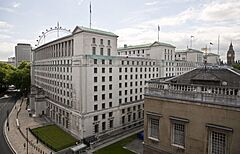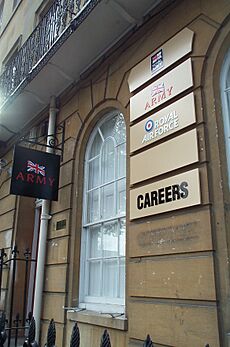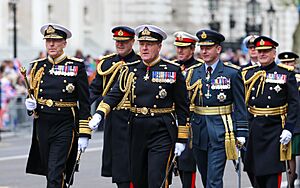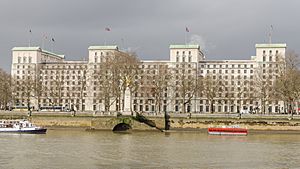Ministry of Defence (United Kingdom) facts for kids
 |
|
 MoD Main Building, Westminster |
|
| Department overview | |
|---|---|
| Formed | 1 April 1964 (as modern department) |
| Jurisdiction | Government of the United Kingdom |
| Headquarters | Main Building, Whitehall, Westminster, London 51°30′14″N 0°07′30″W / 51.5040°N 0.1249°W |
| Employees |
|
| Annual budget | £55 billion; FY 2021 |
| Secretary of State responsible | |
| Department executives |
|
| Child agencies |
|
The Ministry of Defence (often called MOD or MoD) is a special part of the Government of the United Kingdom. Its main job is to make sure the UK is safe and secure. It also acts as the main office for the British Armed Forces, which include the Royal Navy, the British Army, and the Royal Air Force.
The MOD's most important goals are to protect the United Kingdom of Great Britain and Northern Ireland and its interests around the world. It also works to make international peace and stability stronger. The MOD handles the daily tasks of the armed forces, plans for emergencies, and buys new equipment.
Experts from the Defence Select Committee check how the MOD spends money, how it is run, and its policies. This helps make sure everything is done correctly. The Ministry of Defence also takes part in some business activities. For example, in 2025, they announced a deal to supply Norway with warships. This was a very large export deal for the UK. It was expected to create many jobs and support hundreds of businesses.
Contents
A Look at MOD History
For a long time, the different parts of the UK's armed forces – the Navy, Army, and Air Force – worked separately. After the First World War, leaders realized they needed to work together more closely. They wanted to make sure all parts of the military could plan and act as one team.
In 1923, the Chiefs of Staff Committee was created to help these services coordinate. Later, during the 1930s, a "Minister for Co-ordination of Defence" was appointed. This person's job was to help bring the different military branches together.
During Winston Churchill's time as Prime Minister in 1940, he created the role of Minister of Defence. This minister helped oversee the military leaders and coordinate all defence matters. In 1946, the Ministry of Defence Act officially established a new Ministry of Defence. This new ministry brought the leaders of the Navy, Army, and Air Force under one main minister.
Finally, in 1964, the separate departments for the Navy, Army, and Air Force officially merged. They all became part of the modern Ministry of Defence we know today. This big change helped to make sure all parts of the UK's defence worked together as a single, strong team.
Managing Defence Projects and Resources
Running a large organization like the Ministry of Defence involves careful planning and managing many important projects. The MOD is responsible for making sure the armed forces have the best equipment and training. This includes everything from new ships and aircraft to uniforms and supplies.
Managing these big projects can be complex. The MOD works hard to use its resources wisely and ensure that all defence activities are well-managed. This helps to make sure that the UK's defence is strong and ready for any challenge.
Who Leads the Ministry of Defence?
The Ministry of Defence has many important leaders. These include political leaders (ministers), top military officers, and senior civilian staff. They all work together to protect the UK and manage the armed forces.
Ministers and Their Roles
The political leaders of the MOD are called Ministers. They are chosen by the government and have different responsibilities. The most important minister is the Secretary of State for Defence. This person is in charge of the entire department and makes big decisions about defence policy.
Other ministers help with specific areas, such as:
- Looking after new equipment and technology.
- Supporting the brave men and women in the armed forces.
- Helping veterans after their service.
Here are the current Ministers in the Ministry of Defence:
| Minister | Portrait | Office | Portfolio |
|---|---|---|---|
| John Healey MP |  |
Secretary of State for Defence | Overall responsibility for the department; strategic operations and operational strategy, including as a member of the National Security Council; defence planning, programme and resource allocation; strategic international partnerships: US, France, Germany, Saudi Arabia and the Gulf, NATO; nuclear operations, policy and organisations; strategic communications. |
| Lord Coaker |  |
Minister of State for Defence | Corporate governance including transformation programme; single departmental plan, risk reporting and health, safety and security; EU relations, including Brexit (excluding No Deal planning); engagement with retired senior Defence personnel and wider opinion formers; arms control and counter-proliferation, including strategic export licensing and chemical and biological weapons; UK Hydrographic Office; Statutory Instrument programme; Australia, Asia and Far East defence engagement; Defence Fire and Rescue; safety and security; Scotland, Wales and Northern Ireland devolved authorities; ship wrecks, museums and heritage; Ministry of Defence Police; ministerial correspondence and PQs |
| Maria Eagle MP |  |
Minister of State for Defence Procurement | Defence procurement; defence industrial strategy; economic growth and export campaigns; export licensing and controls; defence industry relationships; acquisition reform; equipment plan; defence estates; Defence Infrastructure Organisation (DIO); Defence Digital; science and technology; research and development; single source contract regulations; shipbuilding; multi-lateral capability programmes and organisations |
| Luke Pollard MP |  |
Parliamentary Under-Secretary of State for the Armed Forces | Recruitment and readiness; Afghan resettlement and relocation; Ukraine support; Armed Forces Commissioner; climate change and sustainability; force generation, posture and deployment; global operational policy and commitments; crisis response; Permanent Joint Operating Bases; military aid to civilian authorities; national resilience; Armed Forces Parliamentary Scheme |
| Alistair Carns MP |  |
Parliamentary Under-Secretary of State for Veterans and People | Veterans policy and delivery; civilian workforce; armed forces people policy; armed forces families; Office for Veterans Affairs (OVA); Veterans UK; Armed Forces Covenant; service resettlement; incentivisation; reserves and cadets; equality, diversity and inclusion; pensions and compensation; service charities; Service Justice System; legal |
Top Military Leaders
The most senior military officer in the UK is the Chief of the Defence Staff (CDS). This person is the professional head of all the British Armed Forces. They give important military advice to the Secretary of State for Defence and the Prime Minister.
The CDS works with other top military leaders, including:
- The Vice Chief of the Defence Staff, who helps with daily tasks.
- The heads of the Royal Navy (First Sea Lord).
- The head of the British Army (Chief of the General Staff).
- The head of the Royal Air Force (Chief of the Air Staff).
- The Commander of Strategic Command.
These leaders form the Chiefs of Staff Committee. They work together to plan and carry out military operations.
Civilian Leaders
Besides ministers and military officers, the MOD also has senior civilian leaders. The most important civilian leader is the Permanent Secretary. This person makes sure the department runs smoothly and manages its strategy, performance, and finances.
The Permanent Secretary works closely with the Chief of the Defence Staff. Together, they lead the entire organization and support the ministers in their duties.
What Does the MOD Do?
The Ministry of Defence has clear goals for keeping the UK safe and helping others. These goals guide all their actions and plans.
The main missions for the Armed Forces include:
- Protecting the UK and its overseas territories.
- Providing the country's nuclear deterrent, which is a way to prevent attacks.
- Gathering important information and working with other countries to understand global events.
- Helping to make international security stronger and supporting allies and partners.
The Armed Forces are also ready to help during emergencies. They can:
- Provide humanitarian aid and help during disasters.
- Carry out rescue missions.
- Conduct operations to bring back peace and stability.
- Take part in major combat operations if needed, especially with allies like NATO.
How the MOD is Organized
The Ministry of Defence is a very large organization. It is structured into different groups and committees to manage its many responsibilities effectively.
Governance
Several committees help to govern and manage defence activities. The Defence Council is the formal group that makes sure defence laws are followed. The Defence Board oversees the big picture of defence strategy and how money is spent.
Departmental Organisation

The MOD includes several important groups and agencies:
- Top-level budgets: These are the main financial divisions for operations, readiness, investment, and nuclear defence.
- Executive agencies: These are specialized groups that carry out specific tasks. Examples include:
- Defence Equipment and Support (DE&S), which buys and maintains military equipment.
- Defence Science and Technology Laboratory (Dstl), which does scientific research for defence.
- UK Hydrographic Office (UKHO), which creates maps and charts for the seas.
- Museums: The MOD also supports important museums that tell the story of the armed forces, such as:
- National Museum of the Royal Navy
- National Army Museum
- Royal Air Force Museum
The MOD is also responsible for managing the British military bases in Akrotiri and Dhekelia in Cyprus.
MOD Buildings and Land
The Ministry of Defence is one of the largest landowners in the United Kingdom. It owns a huge amount of land and coastal areas. This land is used for many purposes, such as:
- Training areas and firing ranges for soldiers.
- Research and development facilities.
- Airfields for the Royal Air Force.
- Barracks and camps where service members live and work.
These lands are mostly managed by the Defence Infrastructure Organisation.
The Main Building in London
The main headquarters of the MOD is a very impressive building in Whitehall, London. It is known as the MOD Main Building. This grand building has a classic architectural style. It was built between 1938 and 1959.
Inside the basement of the Main Building, there is a very old wine cellar. It was built for King Henry VIII way back in 1514! During the building's construction after World War II, this entire cellar was carefully moved to a new spot without being damaged. This shows how much care was taken to preserve history.
See also
 In Spanish: Ministerio de Defensa (Reino Unido) para niños
In Spanish: Ministerio de Defensa (Reino Unido) para niños
- Defence Review
- Lancaster House Treaties
- Stabilisation Unit
- Budget of the United Kingdom
- UK National Defence Association




